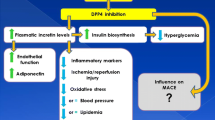Abstract
Five types of oral antihyperglycemic drugs are currently approved for the treatment of diabetes: biguanides, sulfonylureas, meglitinides, glitazones, and α-glucosidase inhibitors. The cardiovascular effects of the most commonly used antidiabetic drugs in these groups are briefly reported, in an attempt to improve knowledge and awareness regarding their influences and potential risks when treating patients with coronary artery disease (CAD). Regarding biguanides, gastrointestinal disturbances such as diarrhea are frequent, and the intestinal absorption of group B vitamins and especially folate is impaired during chronic therapy. This deficiency may lead to increased plasma homocysteine levels which, in turn, accelerate the progression of vascular disease due to adverse effects on platelets, clotting factors, and endothelium. The existence of a graded association between homocysteine levels and overall mortality in patients with CAD is well established. In addition, metformin may lead to lethal lactic acidosis, especially in patients with clinical conditions that predispose to this complication, such as heart failure or recent myocardial infarction. Sulfonylureas avoid ischemic preconditioning. During myocardial ischemia, they may prevent the opening of the ATP-dependent potassium channels, impeding the necessary hyperpolarization that protects the cell by blocking calcium influx. Meglitinides may exert similar effects, due to their analogous mechanism of action. During treatment with glitazones, edema has been reported in 5% of patients, and these drugs are contraindicated in diabetics with NYHA class III or IV cardiac status. The long-term effects of α-glucosidase inhibitors on morbidity and mortality rates and on diabetic micro- and macrovascular complications are yet unknown. The combined sulfonylurea/metformin therapy reveals additive effects on mortality. It is concluded that
(1) four of the five oral antidiabetic drug groups present proven or potential cardiac hazards;
(2) these hazards are not mere “side effects”, but are deeply rooted in the drugs’ mechanism of action;
(3) current data indicate that the combined glibenclamide/metformin therapy seems to present special risk and should be avoided in the long-term management of type 2 diabetics with proven CAD; and
(4) customized antihyperglycemic pharmacological approaches should be investigated for optimal treatment of diabetic patients with heart disease.
Zusammenfassung
Die gegenwärtig zugelassenen oralen Antidiabetika umfassen folgende Substanzklassen: Biguanide, Sulfonylharnstoffe, Meglitinide, Glitazone und α-Glucosidase-Inhibitoren. Diese Übersicht befasst sich mit den kardiovaskulären Wirkungen und Nebenwirkungen der in diesen Substanzklassen am häufigsten verwendeten oralen Antidiabetika und will das Augenmerk auf deren Einfluss und Risiken bei der Behandlung von Patienten mit koronarer Herzkrankheit (KHK) richten. Zu den häufigsten Nebenwirkungen der Biguanide gehören Störungen des Gastrointestinaltrakts, so das Auftreten von Diarrhöen und die Malabsorption der B-Vitamine, insbesondere der Folsäure, bei chronischer Anwendung. Vitamin-B-Mangel kann zu erhöhten Homocysteinspiegeln führen, die ihrerseits durch negative Einflüsse auf Thrombozyten, Gerinnungsfaktoren und das Gefäßendothel zur Progression der KHK beitragen. Dass eine Korrelation zwischen erhöhten Homocysteinspiegeln und einer Zunahme der kardiovaskulären Mortalität besteht, ist durch Studien gut belegt. Metformin kann darüber hinaus zu einer tödlichen Lactacidose führen, eine Komplikation, zu der Herzinsuffizienz und Herzinfarkt in besonderem Maße prädisponieren. Sulfonylharnstoffe verhindern ischämisches „preconditioning“. Sie können während einer Ischämie die Öffnung der ATP-abhängigen K+-Kanäle verhindern, die ansonsten ihrerseits die ischämischen Zellen hyperpolarisieren, womit diese vor einem Calciumeinstrom geschützt wären. Die Meglitinide dürften aufgrund ihres analogen Wirkmechanismus einen ähnlichen Effekt ausüben. Bei der Behandlung mit Glitazonderivaten wurden in 5% der Fälle Ödeme berichtet, und diese Substanzen sind bei Patienten mit NYHA-Stadium III und IV kontraindiziert. Die Langzeitwirkung von α-Glucosidase-Inhibitoren auf die Morbidität und Mortalität sowie auf die diabetische Mikro- und Makroangiopathie ist noch nicht bekannt. Eine kombinierte Behandlung mit Sulfonylharnstoffen und Metformin zeigt eine additive Erhöhung der Mortalität. Deshalb ist festzuhalten, dass
1. vier von fünf oralen Antidiabetika nachgewiesene oder zumindest potentielle kardiovaskuläre Risiken zeigen,
2. diese Risiken nicht nur „Nebenwirkungen“, sondern integraler Bestandteil der pathophysiologischen Wirkung dieser Medikamente sind,
3. die Kombination von Glibenclamid und Metformin ein besonderes kardiovaskuläres Risiko darstellt und bei Patienten mit Typ-2-Diabetes und nachgewiesener KHK vermieden werden sollte und
4. bei dieser Risikogruppe eine individualisierte Therapie mit oralen Antidiabetika, Diät und ggf. auch Insulin durchgeführt werden sollte.
Similar content being viewed by others
Author information
Authors and Affiliations
Corresponding author
Rights and permissions
About this article
Cite this article
Fisman, E.Z., Tenenbaum, A., Motro, M. et al. Oral Antidiabetic Therapy in Patients with Heart Disease. Herz 29, 290–298 (2004). https://doi.org/10.1007/s00059-004-2476-5
Received:
Accepted:
Issue Date:
DOI: https://doi.org/10.1007/s00059-004-2476-5
Key Words:
- α-glucosidase inhibitors
- Biguanides
- Coronary artery disease
- Diabetes
- Glitazones
- Meglitinides
- Sulfonylureas




